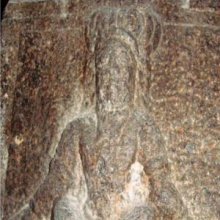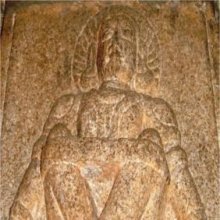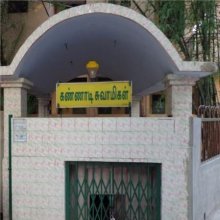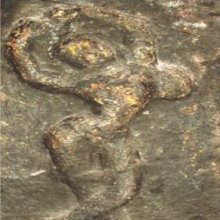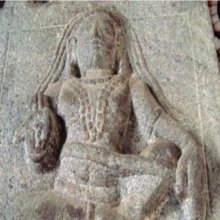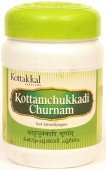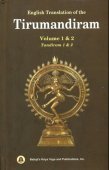Siddha, Siddhā: 52 definitions
Introduction:
Siddha means something in Buddhism, Pali, Hinduism, Sanskrit, Jainism, Prakrit, the history of ancient India, Marathi, biology. If you want to know the exact meaning, history, etymology or English translation of this term then check out the descriptions on this page. Add your comment or reference to a book if you want to contribute to this summary article.
Images (photo gallery)
(+147 more images available)
In Hinduism
Vaishnavism (Vaishava dharma)
Source: ISKCON Press: GlossarySiddha (सिद्ध).—A perfected person, or mystic; a demigod from Siddhaloka; one who has realized the Brahman effulgence; a perfect devotee.
Source: Pure Bhakti: Bhagavad-gita (4th edition)Siddha (सिद्ध) refers to “perfection”. (cf. Glossary page from Śrīmad-Bhagavad-Gītā).

Vaishnava (वैष्णव, vaiṣṇava) or vaishnavism (vaiṣṇavism) represents a tradition of Hinduism worshipping Vishnu as the supreme Lord. Similar to the Shaktism and Shaivism traditions, Vaishnavism also developed as an individual movement, famous for its exposition of the dashavatara (‘ten avatars of Vishnu’).
Purana and Itihasa (epic history)
Source: archive.org: Puranic Encyclopedia1) Siddha (सिद्ध).—A Deva Gandharva. This Gandharva was born to Prajāpati Kaśyapa by his wife Prādhā. (Mahābhārata, Ādi Parva, Chapter 65, Verse 46).
2) Siddha (सिद्ध).—(THE SIDDHAS). A group of Devas. The group of devas called Siddhas lived on the Himālayas near the hermitage of Kaṇva. (Mahābhārata Ādi Parva, Chapter 70, Verse 15). It is mentioned in Mahābhārata, Sabhā Parva, Chapter 8, Verse 29, that this group of Gods stay in the palace of Yama serving him.
3) Siddhā (सिद्धा).—The Devī (goddess) consecrated in Rambhāvana, wearing a water-vessel with a snout, rosary, boon, and fire, is called Siddhā. (See under Devī).
Source: archive.org: Shiva Purana - English TranslationSiddhā (सिद्धा) refers to the “Siddha women”, according to the Śivapurāṇa 2.2.22. Accordingly as Śiva said to Sitā:—“[...] O my beloved, beautiful woman, clouds will not reach the place where I have to make an abode for you. [...] On that mountain at the time when you wish to sport about, the Siddha women will gaily offer you a seat on the jewel-studded platform and gladly present you with fruits and other gifts”.
Source: Cologne Digital Sanskrit Dictionaries: The Purana Index1a) Siddha (सिद्ध).—A son of Krodha and a deva gandharva.*
- * Brahmāṇḍa-purāṇa III. 6. 38.
1b) Invisible celestials;1 impart wisdom;2 and sing in praise of Hari;3 came to see Kṛṣṇa;4 Kapila was the greatest of siddhas;5 vanquished by Rāvaṇa in Jambūdvīpa;6 wander in this world in the guise of Brahmans; hence guests must be fed worthy of them; devas are Yogeśvaras and move for the promotion of dharma in different guises.7
- 1) Bhāgavata-purāṇa II. 6. 13; III. 20. 44; V. 1. 8; VI. 2. 32; 7. 3-4; VII. 8. 37-8.
- 2) Ib. VIII. 14. 8; 23. 26.
- 3) Ib. X. 3. 6; 4. 11; 10. 28: 25. 31: 39. 44; 62. 19; 85. 41.
- 4) Ib. XI. 6. 3; 12. 3; 14. 5.
- 5) Ib. XI. 16. 15; 24. 12; 31. 2; XII. 12. 6.
- 6) Brahmāṇḍa-purāṇa II. 15. 10; III. 7. 255; IV. 20. 46; 30. 9; 33, 3, 39. 56.
- 7) Vāyu-purāṇa 23. 191; 30. 88, 34. 21; 38. 58. 47. 46; 71. 74; 72. 35.
2a) Siddhā (सिद्धा).—The presiding deity of Sarvarohahara cakra.*
- * Brahmāṇḍa-purāṇa IV. 37. 9.
2b) Another name for Kumārī.*
- * Vāyu-purāṇa 49. 92.
Siddha (सिद्ध).—Purāṇa also describes Siddhas by grouping them with Devariṣis, Pannagas, Yakśas, Gandharvas, Kinnaras etc. The kesin referred to in the Ṛg Veda is very similar to Siddhas.
Source: JatLand: List of Mahabharata people and placesSiddha (सिद्ध) is a name mentioned in the Mahābhārata (cf. I.59.45, I.65, III.82.4, VI.10.55, III.174.9, VIII.44.32, IX.36.21, XIV.8.17, XIV.8) and represents one of the many proper names used for people and places. Note: The Mahābhārata (mentioning Siddha) is a Sanskrit epic poem consisting of 100,000 ślokas (metrical verses) and is over 2000 years old.

The Purana (पुराण, purāṇas) refers to Sanskrit literature preserving ancient India’s vast cultural history, including historical legends, religious ceremonies, various arts and sciences. The eighteen mahapuranas total over 400,000 shlokas (metrical couplets) and date to at least several centuries BCE.
Kavya (poetry)
Source: Wisdom Library: Kathāsaritsāgara1) Siddha (सिद्ध) is a Sanskrit name referring to a group of deities, attending Maheśvara at his dwelling place, which is the mountain-peak Kailāsa (located within Himavat), according to the Kathāsaritsāgara, chapter 1. Accordingly, “There (Kailāsa) dwells Maheśvara the beloved of Pārvatī, the chief of things animate and inanimate, attended upon by Gaṇas, Vidyādharas and Siddhas”.
2) Siddhā (सिद्धा) is one of the epithets of Durgā, according to the Kathāsaritsāgara, chapter 53. Accordingly, as Vīravara praised Durgā: “... thou art the principle of life in creatures; by thee this world moves. In the beginning of creation Śiva beheld thee self-produced, blazing and illuminating the world with brightness hard to behold, like ten million orbs of fiery suddenly produced infant suns rising at once, filling the whole horizon with the circle of thy arms, bearing a sword, a club, a bow, arrows and a spear. And thou wast praised by that god Śiva in the following words ... [Siddhā, etc...]”.
Also, “... when Skanda, and Vasiṣṭha, and Brahmā, and the others heard thee praised, under these [eg., Siddhā] and other titles, by Śiva well skilled in praising, they also praised thee. And by praising thee, O adorable one, immortals, Ṛṣis and men obtained, and do now obtain, boons above their desire. ”
The Kathāsaritsāgara (‘ocean of streams of story’), mentioning Siddha, is a famous Sanskrit epic story revolving around prince Naravāhanadatta and his quest to become the emperor of the vidyādharas (celestial beings). The work is said to have been an adaptation of Guṇāḍhya’s Bṛhatkathā consisting of 100,000 verses, which in turn is part of a larger work containing 700,000 verses.

Kavya (काव्य, kavya) refers to Sanskrit poetry, a popular ancient Indian tradition of literature. There have been many Sanskrit poets over the ages, hailing from ancient India and beyond. This topic includes mahakavya, or ‘epic poetry’ and natya, or ‘dramatic poetry’.
Natyashastra (theatrics and dramaturgy)
Source: Wisdom Library: Nāṭya-śāstraSiddha (सिद्ध) refers to a group of deities whose beard (śmaśru) should be represented as vicitra (smartly done), according to Nāṭyaśāstra chapter 23. Providing the beard is a component of nepathya (costumes and make-up) and is to be done in accordance with the science of āhāryābhinaya (extraneous representation).

Natyashastra (नाट्यशास्त्र, nāṭyaśāstra) refers to both the ancient Indian tradition (shastra) of performing arts, (natya—theatrics, drama, dance, music), as well as the name of a Sanskrit work dealing with these subjects. It also teaches the rules for composing Dramatic plays (nataka), construction and performance of Theater, and Poetic works (kavya).
Shaivism (Shaiva philosophy)
Source: Wikipedia: ShaivismIn Tamil Nadu, South India, a Siddha (see Siddhar) refers to a being who has achieved a high degree of physical as well as spiritual perfection or enlightenment. The ultimate demonstration of this is that Siddhas allegedly attained physical immortality. Thus Siddha, like Siddhar, refers to a person who has realised the goal of a type of sadhana and become a perfected being.
Source: DSpace at Pondicherry: Siddha Cult in TamilnaduSiddha (सिद्ध).—A Siddha is one who has realized” the non-duality of jīva (the psyche) and Śiva. He is one who has realized Śiva in himself. He is said to have attained Śivāṉubhava. Śivāṉubhava stands for the state of experiencing the non-duality or oneness between the experiencing jīva and Śiva
The Siddhas are the great human teachers who attained aṣtasiddhis (powers) through their yogic practices. These eight supernatural powers of the Siddhas are also elaborately described in the ‘Siddhar Kaṇam’ of Saint Tāyumāṉavar. He had sung nearly ten songs, in which many of the names of the Siddhas are mentioned by him.
According to Kamil V. Zvelebil, “A Siddha or Mahāsiddha is an yogin who has acquired siddha, that is, ‘power, prowess, strength, ability”. He also says that the designation ‘Siddha’ is also a name of a sect in North India partly synonymous with Nātha.
Source: Shodhganga: Iconographical representations of ŚivaSiddha (सिद्ध) or Siddhāgama refers to one of the twenty-eight Siddhāntāgama: a classification of the Śaiva division of Śaivāgamas. The Śaivāgamas represent the wisdom that has come down from lord Śiva, received by Pārvatī and accepted by Viṣṇu. The Śaivāgamas are divided into four groups viz. Śaiva, Pāśupata, Soma and Lākula. Śaiva is further divided in to Dakṣiṇa, Vāma and Siddhānta (e.g., siddha).
Source: SOAS University of London: Protective Rites in the Netra TantraSiddha (सिद्ध) refers to “perfection”, according to the Netratantra of Kṣemarāja: a Śaiva text from the 9th century in which Śiva (Bhairava) teaches Pārvatī topics such as metaphysics, cosmology, and soteriology.—Accordingly, [verse 21.6-9ab]—“But, if [mantras consist of] the forms of Śakti, whose Śakti and of what kind? O Deva, what [does] Śakti cause, what is her purpose, and of what kind is she? If [mantras] do not possess Śakti, what is worshipped with Śakti? Independence cannot be accomplished by anyone without perfection (siddha). What is conquerable [by one who is] imperfect (asiddha)? [...]”.
Source: HAL: The function of the Vṛṣasārasaṃgraha in the Śivadharma corpusSiddha (सिद्ध) refers to one of the Six Āśramas referred to by Kauṇḍinya in his comments on Pāśupatasūtra 3.1.—The system of the four Brahmanical Āśramas also survived practically intact during the time of the Tantric and non-Tantric manifestations of Śaivism and Vaiṣṇavism The editor of the Trivandrum edition of the Pāśupatasūtra gives a list in explanation of the phrase ‘Six Āśramas’ [e.g., Siddha]. This interpretation is probably based on Kauṇḍinya ad Pāśupatasūtra 1.6 and 4.18 (“the paths of the householder, the chaste student, the forest-dweller, the mendicant, and the heretic are wrong paths”).

Shaiva (शैव, śaiva) or Shaivism (śaivism) represents a tradition of Hinduism worshiping Shiva as the supreme being. Closely related to Shaktism, Shaiva literature includes a range of scriptures, including Tantras, while the root of this tradition may be traced back to the ancient Vedas.
Vedanta (school of philosophy)
Source: DSpace at Pondicherry: Siddha Cult in Tamilnadu (upanishad)Siddha (सिद्ध).—According to Śvetaśvatara Upaniṣad, the Siddhas are those who possessed from birth the “superhuman” powers, as also of “knowledge and indifference to the world”.
Source: Shodhganga: Siva Gita A Critical StudySiddha (सिद्ध) or Siddhagītā refers to one of the sixty-four Gītās commonly referred to in Hindu scriptures.—Gītā is the name given to certain sacred writings in verse (often in the form of a dialogue) which are devoted to the exposition of particular religious and theosophical doctrines. Most of these Gītās [i.e., Siddha-gītā] originate from the Mahābhārata or the various Purāṇas.

Vedanta (वेदान्त, vedānta) refers to a school of orthodox Hindu philosophy (astika), drawing its subject-matter from the Upanishads. There are a number of sub-schools of Vedanta, however all of them expound on the basic teaching of the ultimate reality (brahman) and liberation (moksha) of the individual soul (atman).
Jyotisha (astronomy and astrology)
Source: academia.edu: Tithikarmaguṇa in GārgīyajyotiṣaSiddhā (सिद्धा) or Siddhatithi is the name of the last of fifteen tithis (cycle of time) according to the Śārdūlakarṇāvadāna while the Gārgīyajyotiṣa considers Saumyā to be the fifteenth. The associated deity for Siddhā or Saumyā according to the Bṛhatsaṃhitā are the Pitṛs. A tithi was defined as one thirtieth of a synodic month (c. 29.5 days), resulting in an average tithi being slightly less than a day.
Accordingly, “(39) The New Moon is Siddhārthā. The worship of ancestors is praised on this tithi. One should enter sanctuaries (gokulāni) where there are holy rites and fire rites. (40) One should appoint a Purohita and perform sacrificial rites, make offerings and occasional oblations. The ancestors are the deity on this tithi”.
Also, “(41) The Full Moon is Kalyāṇī. One should engage in duties for the gods, acts for the Brahmans and kindle the sacrificial fire. One should devote to the sounds of the cattle. (42) One should appoint Purohitas and perform various rites for the kings. Auspicious acts should be performed. One should know Soma as the deity”.

Jyotisha (ज्योतिष, jyotiṣa or jyotish) refers to ‘astronomy’ or “Vedic astrology” and represents the fifth of the six Vedangas (additional sciences to be studied along with the Vedas). Jyotisha concerns itself with the study and prediction of the movements of celestial bodies, in order to calculate the auspicious time for rituals and ceremonies.
Vyakarana (Sanskrit grammar)
Source: Wikisource: A dictionary of Sanskrit grammar1) Siddha (सिद्ध).—Established; the term is used in the sense of नित्य (nitya) or eternal in the Varttika सिद्धे शब्दार्थसंबन्धे (siddhe śabdārthasaṃbandhe) where, as Patanjali has observed, the word सिद्ध (siddha) meaning नित्य (nitya) has been purposely put in to mark an auspicious beginning of the शब्दानुशासनशास्त्र (śabdānuśāsanaśāstra) which commences with that Varttika; cf. माङ्गलिक आचार्यो महतः शास्त्रौघस्य मङ्गलार्थे सिद्धशब्दमादितः प्रयुङ्क्ते (māṅgalika ācāryo mahataḥ śāstraughasya maṅgalārthe siddhaśabdamāditaḥ prayuṅkte) M.Bh.on Ahnika 1;
2) Siddha.—Established, proved, formed; the word is many times used in this sense in the Mahabhasya, as also in the Varttikas especially when a reply is to be given to an objection; cf. P.I. 1.3 Vart. 17, I.1. 4. Vart. 6: I. 1. 5, Vart.5,I.1.9 Vart. 2 etc.
Source: Knowledge Traditions & Practices of India: Language and Grammar (vyakarana)Siddha (सिद्ध) refers to “inflected words” according to Pāṇini (7th century BCE): author of the Aṣṭādhyāyī dealing with vyākaraṇa (grammar): the science of analysis of sentences and words. Sentences that meet the rules of Pāṇini’s grammar are accepted as siddha, literally ‘ripe’ or ‘mature’. In English grammar, we say the sentence is ‘grammatical’.

Vyakarana (व्याकरण, vyākaraṇa) refers to Sanskrit grammar and represents one of the six additional sciences (vedanga) to be studied along with the Vedas. Vyakarana concerns itself with the rules of Sanskrit grammar and linguistic analysis in order to establish the correct context of words and sentences.
Pancaratra (worship of Nārāyaṇa)
Source: archive.org: Isvara Samhita Vol 5Siddha (सिद्ध) or Siddhamudrā is the name of a mudrā described in the Īśvarasaṃhitā 61-63.—Accordingly, “the two hands are to be turned upwards and placed at the navel the right hand being placed on the back of the left. This mudrā belongs to the line of the Siddhas. This mudrā, shall be, O Brahmins! Añjali for all others; likewise for the attendants, those who dwell at the enclosures of entrance. This shall be employed again and again with their mantras for others while being worshipped in their order. This is to be done again with heart, intellect and head”.
Mūdra (eg., Siddha-mudrā) is so called as it gives joy to the tattvas in the form of karman for those who offer spotless worship, drive out the defects which move about within and without and sealing up of what is done.

Pancaratra (पाञ्चरात्र, pāñcarātra) represents a tradition of Hinduism where Narayana is revered and worshipped. Closeley related to Vaishnavism, the Pancaratra literature includes various Agamas and tantras incorporating many Vaishnava philosophies.
Ayurveda (science of life)
Nighantu (Synonyms and Characteristics of Drugs and technical terms)
Source: WorldCat: Rāj nighaṇṭuSiddhā (सिद्धा) is another name for Ṛddhi, an unidentified medicinal plant, according to verse 5.28-33 of the 13th-century Raj Nighantu or Rājanighaṇṭu. The fifth chapter (parpaṭādi-varga) of this book enumerates sixty varieties of smaller plants (kṣudra-kṣupa). Together with the names Siddhā and Ṛddhi, there are a total of twelve Sanskrit synonyms identified for this plant.
Veterinary Medicine (The study and treatment of Animals)
Source: archive.org: The Elephant Lore of the HindusSiddha (सिद्ध) refers to the “perfect sensitivity” (of certain elephants), according to the 15th century Mātaṅgalīlā composed by Nīlakaṇṭha in 263 Sanskrit verses, dealing with elephantology in ancient India, focusing on the science of management and treatment of elephants.—[Cf. chapter 8, “on marks of character”]: “18. The sensitiveness (to stimuli of control) of elephants is known to be seven-fold according as it is extreme, shallow, deep, conformable to meaning, contrary to meaning, harsh, and perfect (siddha). 25. Who is gentle in all his feelings (or, in all conditions), and free from vice, the best of the best, that elephant the noble sages call one of perfect sensitivity (siddhavedana)”.

Āyurveda (आयुर्वेद, ayurveda) is a branch of Indian science dealing with medicine, herbalism, taxology, anatomy, surgery, alchemy and related topics. Traditional practice of Āyurveda in ancient India dates back to at least the first millenium BC. Literature is commonly written in Sanskrit using various poetic metres.
Shaktism (Shakta philosophy)
Source: Google Books: Manthanabhairavatantram1) Siddha (सिद्ध) is the name of the Monastery (maṭhas) associated with Kāmarūpa, one of the sacred seats (pīṭha), according to chapter 10 of the according to the Kularatnoddyota, one of the earliest Kubjikā Tantras.—If the scheme in the Yogakhaṇḍa is not the first example of this model, the other most likely candidate is found in chapter ten of the Kularatnoddyota, which is an early Tantra of the Kubjikā corpus. [...] In this set-up each of the four sacred seats corresponds to a cosmic age and has a tree, creeper, cave, monastery (maṭha) [i.e., Siddha], goddess, Siddha, and guardian of the field. The layout can be tabulated as follows.
2) Siddha (सिद्ध) is the name of the Cave associated with Pūrṇagiri, one of the sacred seats (pīṭha), according to the Ṣaṭsāhasrasaṃhitā, an expansion of the Kubjikāmatatantra: the earliest popular and most authoritative Tantra of the Kubjikā cult.
3) Siddha (सिद्ध) is also the name of the Cave associated with Kāmarūpa, one the eight Sacred Seats (pīṭha) mentioned in the Yogakhaṇḍa (chapter 14) of the Manthānabhairavatantra, a vast sprawling work that belongs to a corpus of Tantric texts concerned with the worship of the goddess Kubjikā.—(Note the variant Siddhi)
4) Siddha (सिद्ध) is the name of the Maṭha associated with Kāmarūpa, according to the same Yogakhaṇḍa.
5) Siddhā (सिद्धा) refers to one of the Consorts of Vīrānanda: one of the Nine Nāthas according to the Kulakaulinīmata.—Vīrānanda is the Caryā name of this Nātha (i.e., the public name the Siddha uses when living as a wandering renouncer). His consorts are Siddhā (Siddhaśarīra, Jayā, Ciddruma) [Alternatively Siddheśvarī according to the Kubjikānityāhnikatilaka].
6) Siddha (सिद्ध) or Siddhānanda is the “worship name” of Vaṭapura—one of the Sixteen Siddhas according to the Kubjikānityāhnikatilaka: a derative text drawing from Tantras and other sources such as the Ṣaṭsāhasrasaṃhitā.—These sixteen spiritual teachers represent the disciples of the Nine Nāthas who propagated the Western Transmission noted in the Kubjikā Tantras.—Vaṭapura is the Caryā name of this Nātha (i.e., the public name the Siddha uses when living as a wandering renouncer). His Prapūjya or “worship name” is Siṃhānanda (or Siddha-Ānanda). This Pūjā name is the one by which the Siddhas are worshipped.

Shakta (शाक्त, śākta) or Shaktism (śāktism) represents a tradition of Hinduism where the Goddess (Devi) is revered and worshipped. Shakta literature includes a range of scriptures, including various Agamas and Tantras, although its roots may be traced back to the Vedas.
Ganitashastra (Mathematics and Algebra)
Source: archive.org: Hindu MathematicsSiddha (सिद्ध) represents the number 24 (twenty-four) in the “word-numeral system” (bhūtasaṃkhyā), which was used in Sanskrit texts dealing with astronomy, mathematics, metrics, as well as in the dates of inscriptions and manuscripts in ancient Indian literature.—A system of expressing numbers by means of words arranged as in the place-value notation was developed and perfected in India in the early centuries of the Christian era. In this system the numerals [e.g., 24—siddha] are expressed by names of things, beings or concepts, which, naturally or in accordance with the teaching of the Śāstras, connote numbers.

Ganita (गणित) or Ganitashastra refers to the ancient Indian science of mathematics, algebra, number theory, arithmetic, etc. Closely allied with astronomy, both were commonly taught and studied in universities, even since the 1st millennium BCE. Ganita-shastra also includes ritualistic math-books such as the Shulba-sutras.
In Buddhism
Tibetan Buddhism (Vajrayana or tantric Buddhism)
Source: Wisdom Library: Tibetan Buddhism1a) Siddha (सिद्ध) is the name of a Tathāgata (Buddha) mentioned as attending the teachings in the 6th century Mañjuśrīmūlakalpa: one of the largest Kriyā Tantras devoted to Mañjuśrī (the Bodhisattva of wisdom) representing an encyclopedia of knowledge primarily concerned with ritualistic elements in Buddhism. The teachings in this text originate from Mañjuśrī and were taught to and by Buddha Śākyamuni in the presence of a large audience (including Siddha).
1b) Siddha (सिद्ध) also refers to a group of deities summoned by the Yamāntaka-mantra and mentioned as attending the teachings in the 6th century Mañjuśrīmūlakalpa.
2) Siddhā (सिद्धा) is the name of Dūtī (i.e., messengers of Lord Vajrapāṇi) mentioned as attending the teachings in the 6th century Mañjuśrīmūlakalpa.
Source: Google Books: The Crystal Mirror of Philosophical SystemsSiddha (सिद्ध) (Sanskrit; in Tibetan: grub pa) — (lit. “Adept”) — A bodhisattva who has, through tantric practice, gained both worldly and transmundane yogic achievements . The great adepts of medieval India, whose lifestories are both colorful and inspirational, were instrumental in transmitting the tantras and are at the source of many Tibetan practice lineages
Source: 84000: Sampuṭodbhava Tantra (Emergence from Sampuṭa)Siddhā (सिद्धा) refers to one of the primary thirty-two energy-channels in the body, according to the Sampuṭodbhavatantra chapter 1.—Accordingly, “[Vajragarbha asked, ‘What subtle energy channels are in the body?’]—The Blessed One said, ‘There are one hundred and twenty of them, corresponding to the divisions within the four cakras. The chief ones, those with bodhicitta as their innate nature, are thirty-two in number. They are: [i.e., Siddhā] [...]’.”.

Tibetan Buddhism includes schools such as Nyingma, Kadampa, Kagyu and Gelug. Their primary canon of literature is divided in two broad categories: The Kangyur, which consists of Buddha’s words, and the Tengyur, which includes commentaries from various sources. Esotericism and tantra techniques (vajrayāna) are collected indepently.
Mahayana (major branch of Buddhism)
Source: academia.edu: A Study and Translation of the GaganagañjaparipṛcchāSiddha (सिद्ध) refers to “(that which) accomplishes”, according to the Gaganagañjaparipṛcchā: the eighth chapter of the Mahāsaṃnipāta (a collection of Mahāyāna Buddhist Sūtras).—Accordingly, “[...] Son of good family, how does the recollection of morality (śīlānusmṛti) of Bodhisattva becomes like open space? What we called ‘morality (śīla)’ is unconditioned, unsullied, no wishful thinking, effortless. It accomplishes vows (siddha-vrata), fulfils the vows, and has the character of being beyond information. Since it is established by concentration, it is not established in the object of thought. Since it is the root of insight, it is without essential characteristic of discursive thinking. Since it is the outcome of liberation, it is not distinguished by duality. [...]”.

Mahayana (महायान, mahāyāna) is a major branch of Buddhism focusing on the path of a Bodhisattva (spiritual aspirants/ enlightened beings). Extant literature is vast and primarely composed in the Sanskrit language. There are many sūtras of which some of the earliest are the various Prajñāpāramitā sūtras.
General definition (in Buddhism)
Source: DSpace at Pondicherry: Siddha Cult in Tamilnadu (buddhism)Siddha (सिद्ध).—In Buddhism it denotes a class of saints who have attained Siddhi or perfection in Tāntric rites.
In Jainism
General definition (in Jainism)
Source: archive.org: TrisastisalakapurusacaritraSiddha (सिद्ध) refers to “one who has obtained magic powers” and represents one of the eight divisions of Prabhāvanā (“propogation”), according to chapter 1.1 [ādīśvara-caritra] of Hemacandra’s 11th century Triṣaṣṭiśalākāpuruṣacaritra: an ancient Sanskrit epic poem narrating the history and legends of sixty-three illustrious persons in Jainism.—Accordingly, “[...] Vajranābha acquired strong Tirthakṛt-body-making and family-karma by the twenty sthānakas as follows:—[...] The twentieth is the propagation of the doctrine by Vidyās, prognostication, literary composition, discussion, discourses on dharma, etc. [viz., Siddha] Of these (i.e., of the twenty) one is cause for gaining tīrthakṛtnāma-karma”.—(Cf. note 120 and Yogaśāstra 2.16, p. 65)
Source: archive.org: Bhagavati SutraSiddha (सिद्ध) refers to “(one who is) perfected”, according to the Bhagavatīsūtra , book 8 chapter 5.—Accordingly, “[...] [Question].—Bhante! Does a monk who has restrained the cycles of coming and going,...till who has completed his work, acquire again, on death, the existence and other conditions of human life? [Answer].—Gautama! A monk who has restrained the cycles,...till, on death, docs not acquire the existence and other conditions of human life. [Question].—Bhante! How is he to be called? [Answer].—Gautama! He may be called Siddha, he may be called Buddha, he may be called pāragata, he may be called paramparāgata; he may be called siddha, buddha, mukta, nibṛtta [i.e., parinirvṛta], anta-kṛta and sarva-dukkha-prahīṇa”.
Source: DSpace at Pondicherry: Siddha Cult in Tamilnadu (jainism)Siddha (सिद्ध).—In Jainism, this term is equivalent to the designation tīrthaṅkara.
Source: Encyclopedia of Jainism: Tattvartha Sutra 2: the Category of the livingSiddha (सिद्ध).—How many types of dispositions are there for pure souls (siddhas)? Pure souls have two types of dispositions namely due to destruction of karmas and due to the inherent nature of the soul. What are the dispositions (bhāva) of siddhas? These are four due to destruction of karmas and one due to the inherent nature of the soul.

Jainism is an Indian religion of Dharma whose doctrine revolves around harmlessness (ahimsa) towards every living being. The two major branches (Digambara and Svetambara) of Jainism stimulate self-control (or, shramana, ‘self-reliance’) and spiritual development through a path of peace for the soul to progess to the ultimate goal.
India history and geography
Source: Google Books: The Encyclopedia of Ayurvedic Massage (history)Siddha medicine is a system of medicine that was brought to the south of India by the great siddhar or sage Agastya. It is said that Siddha medicine is the oldest system of medicine in the world, with siddhars claiming it to be 8,000 years old. It has two branches: Siddha medicine and Siddha massage. It was in the South under the auspices of Agastya nd the eighteen great siddhars that the techniques of detoxification processes called panchakarma and kya kalpa were developed.
Source: DSpace at Pondicherry: Siddha Cult in Tamilnadu (historical)Siddha in the context of South Indian Tamiḻ culture, the Siddhas (cittar) are those who have attained the eight great supernatural powers (aṣtasiddhis), use their achievement in medical cure and/or alchemy, and express their views and doctrine in prose and verse composed in Tamiḻ.
Source: Cologne Digital Sanskrit Dictionaries: Indian Epigraphical GlossarySiddha.—(CII 4), a person possessing miraculous powers; an emancipated person. (CII 3), ‘a perfect one’; the epithet of a class of Jain saints who are invoked in the plural. (LL), a Jain saint. (CII 4), cf. siddham (q. v.), used at the beginning of ins- criptions to ensure the success of the undertaking and meaning siddhir = astu, ‘let there be success’. Cf. siddhi. (IE 7-1-2), ‘twenty-four’. Note: siddha is defined in the “Indian epigraphical glossary” as it can be found on ancient inscriptions commonly written in Sanskrit, Prakrit or Dravidian languages.
--- OR ---
Siddha.—(IE 8-5), income from land under cultivation. See siddha-aya, etc. (SITI), also called siddhi; the right of cultivating land; one of the eight kinds of enjoying landed property; may be the same as abbyantara-siddhi. See siddha, siddha-aya, ūrdhv-ādhaḥ-siddhi. Note: siddha is defined in the “Indian epigraphical glossary” as it can be found on ancient inscriptions commonly written in Sanskrit, Prakrit or Dravidian languages.

The history of India traces the identification of countries, villages, towns and other regions of India, as well as mythology, zoology, royal dynasties, rulers, tribes, local festivities and traditions and regional languages. Ancient India enjoyed religious freedom and encourages the path of Dharma, a concept common to Buddhism, Hinduism, and Jainism.
Biology (plants and animals)
Source: Google Books: CRC World Dictionary (Regional names)Siddha in India is the name of a plant defined with Altingia excelsa in various botanical sources. This page contains potential references in Ayurveda, modern medicine, and other folk traditions or local practices It has the synonym Liquidambar altingiana Blume.
Example references for further research on medicinal uses or toxicity (see latin names for full list):
· Journal of the Arnold Arboretum (1977)
· Species Plantarum (1753)
· Verhandelingen van het bataviaasch genootschap van kunsten en wetenschappen (1790)
If you are looking for specific details regarding Siddha, for example chemical composition, extract dosage, health benefits, diet and recipes, pregnancy safety, side effects, have a look at these references.

This sections includes definitions from the five kingdoms of living things: Animals, Plants, Fungi, Protists and Monera. It will include both the official binomial nomenclature (scientific names usually in Latin) as well as regional spellings and variants.
Languages of India and abroad
Pali-English dictionary
Source: BuddhaSasana: Concise Pali-English Dictionarysiddha : (pp. of sijjhati) happened; succeeded; availed.
Source: Sutta: The Pali Text Society's Pali-English Dictionary1) Siddha, 2 (pp. of sijjhati) ended, accomplished Mhvs 23, 45, 78; successful Miln. 247.—(m.) a kind of semi-divine beings possessed of supernatural faculties, a magician Miln. 120, 267 (cp. Sk. siddha Halāyudha 1, 87; Yogasūtra 3, 33; Aufrecht remarks: “This is a post-vedic mythological fiction formed on the analogy of sādhya”).
2) Siddha, 1 (a specific Pali formation fr. sijjati (svid) in meaning “to cook, ” in analogy to siddha2) boiled, cooked J. II, 435 (=pakka); V, 201 (°bhojana); Miln. 272; SnA 27 (°bhatta=pakk’odana of Sn. 18). (Page 709)

Pali is the language of the Tipiṭaka, which is the sacred canon of Theravāda Buddhism and contains much of the Buddha’s speech. Closeley related to Sanskrit, both languages are used interchangeably between religions.
Marathi-English dictionary
Source: DDSA: The Molesworth Marathi and English Dictionarysiddha (सिद्ध).—p (S) Accomplished, effected, finished, completed, prepared, made. 2 Established, substantiated, evinced, demonstrated, proved; rendered true, valid, good &c. 3 Judged, decided, determined;-as a litigation, cause, suit. 4 Framed, formed, enacted, made;-as an award, a decision, regulation, law, rule. 5 Cooked or dressed;--as food: also prepared, cured, or made (by compounding, concocting &c.);--as a medicine. 6 Ready, prepared, willing and waiting;--as a person to act, an animal or a thing to be employed or used. 7 Adept or accomplished (in alchemy &c.) 8 In grammar. Concrete: contrad. from sādhita Abstract. Also Primitive: contrad. from sādhita Derivative. 9 Used as s m An inspired writer, as Vyasa and others: also a person to whom the past, present, and future are supposed to be known, a seer. 10 A divine personage of undefined attributes or character, a sort of demigod or spirit, inhabiting, together with the Widyadharas, Munis &c., the regions between the earth and sun. 11 An adept, a magician, one who, by the performance of certain mystical and magical rites, has acquired superhuman powers. 12 An ascetic who, by mystical and austere practices, has effected one or all of five purposes; viz. the wealth of the gods, the form of the gods, the society of the gods, residence in any of the divine lokas, identification with a deity. 13 The twenty-first of the astronomical Yogas. Note. Useful compounds are formed with this word as p; e.g. anubhavasiddha, anādisiddha, svabhāvasiddha, pūrvasiddha, pratyakṣasiddha, lōkasiddha, śāstrasiddha, vyākaraṇasiddha, nyāyasiddha, upādhisiddha, kriyāsiddha, jñānasiddha, yōgasiddha, ōṣadhīsiddha &c. Of these some will be found in order. sarva siddha āṇi culīsa pōtērēṃ Used where a person is ever prompt to cry out All's ready; whereas the cowdunging clout is still upon the fireplace (and thus dinner or the dressing of it is remote indeed). siddha is much used after participles in the ūna form; as karūna siddha, pāhūna siddha, aikūna siddha, śikūna siddha, bhōgūna or anubhavūna siddha Perfected, prepared, or become adept through doing, through seeing, through hearing about &c.
Source: DDSA: The Aryabhusan school dictionary, Marathi-Englishsiddha (सिद्ध).—p Accomplished. Cooked. Proved. Ready. Judged. Primitive. m An adept. An ascetic.
Marathi is an Indo-European language having over 70 million native speakers people in (predominantly) Maharashtra India. Marathi, like many other Indo-Aryan languages, evolved from early forms of Prakrit, which itself is a subset of Sanskrit, one of the most ancient languages of the world.
Sanskrit dictionary
Source: DDSA: The practical Sanskrit-English dictionarySiddha (सिद्ध).—p. p.
1) Accomplished, effected, performed, achieved, completed.
2) Gained, obtained, acquired.
3) Succeeded, successful; one who has attained his object; याताबला व्रजं सिद्धा मयेमा रंस्थथ क्षपाः (yātābalā vrajaṃ siddhā mayemā raṃsthatha kṣapāḥ) Bhāgavata 1.22.27.
4) Settled, established; नैसर्गिकी सुरभिणः कुसुमस्य सिद्धा मूर्ध्नि स्थितिर्न चरणैरवताडनानि (naisargikī surabhiṇaḥ kusumasya siddhā mūrdhni sthitirna caraṇairavatāḍanāni) Uttararāmacarita 1.14.
5) Proved, demonstrated, substantiated; तस्मादिन्द्रियं प्रत्यक्षप्रमाणमिति सिद्धम् (tasmādindriyaṃ pratyakṣapramāṇamiti siddham) T. S.; साक्षिप्रत्ययसिद्धानि (sākṣipratyayasiddhāni) (kāryāṇi) Manusmṛti 8.178.
6) Valid, sound (as a rule).
7) Admitted to be true.
8) Decided, adjudicated (as a law-suit).
9) Paid, discharged, liquidated (as debt).
1) Cooked, dressed (as food); अभ्रच्छाया खलप्रीतिः सिद्धमन्नं च योषितः । किंचित्कालोपभोग्यानि यौवनानि धनानि च (abhracchāyā khalaprītiḥ siddhamannaṃ ca yoṣitaḥ | kiṃcitkālopabhogyāni yauvanāni dhanāni ca) ||Pañcatantra (Bombay) 2.117.
11) Matured, ripened.
12) Thoroughly prepared, compounded, cooked together (as drugs).
13) Ready (as money).
14) Subdued, won over, subjugated (as by magic).
15) Brought under subjection, become propitious.
16) Thoroughly conversant with or skilled in, proficient in; as in रस- सिद्ध (rasa- siddha) q. v.
17) Perfected, sanctified (as by penance); अप्रमत्तोऽखिलस्वार्थे यदि स्यात् सिद्ध आत्मनि (apramatto'khilasvārthe yadi syāt siddha ātmani) Bhāgavata 11.23.29.
18) Emancipated.
19) Endowed with supernatural powers or faculties.
2) Pious, sacred, holy.
21) Divine, immortal, eternal.
22) Celebrated, well-known, illustrious; अथर्वशिरसि प्रोक्तैर्मन्त्रैः सिद्धां विधानतः (atharvaśirasi proktairmantraiḥ siddhāṃ vidhānataḥ) Rām.1.15.2; एवं तौ लोकसिद्धाभिः क्रीडाभिश्चेरतुर्वने (evaṃ tau lokasiddhābhiḥ krīḍābhiśceraturvane) Mahābhārata (Bombay) 1.18.16.
23) Shining, splendid.
24) Hit (as a mark).
25) Peculiar, singular.
26) Invariable, unalterable.
27) Satisfied; Bhāgavata 11.23.29.
-ddhaḥ 1 A semi-divine being supposed to be of great purity and holiness, and said to be particularly characterized by eight supernatural faculties called Siddhis q. v.; उद्वेजिता वृष्टिभिराश्रयन्ते शृङ्गाणि यस्यातप- वन्ति सिद्धाः (udvejitā vṛṣṭibhirāśrayante śṛṅgāṇi yasyātapa- vanti siddhāḥ) Kumārasambhava 1.5.
2) An inspired sage or seer (like Vyāsa).
3) Any sage or seer, a prophet; सिद्धादेश (siddhādeśa) Ratnāvalī 1.
4) One skilled in magical arts, a magician.
5) A law-suit, judicial trial.
6) A kind of hard sugar.
7) The dark thorn-apple.
8) One who has attained his object; सिद्धः कचो वत्स्यति मत्सकाशे (siddhaḥ kaco vatsyati matsakāśe) Mahābhārata (Bombay) 1.76.7.
-ddham Sea-salt.
Source: Cologne Digital Sanskrit Dictionaries: Shabda-Sagara Sanskrit-English DictionarySiddha (सिद्ध).—mfn.
(-ddhaḥ-ddhā-ddhaṃ) 1. Accomplished, effected, completed. 2. Liberated, emancipated. 3. Always, eternal. 4. Celebrated, famous. 5. Judged, decided, terminated, (as a law suit.) 6. Valid, (in law.) 7. Adept initiated, in alchemy or magic. 8. Demonstrated, proved, (in logic.) 9. Finished. 10. Cooked, dressed. 11. Prepared, compounded, (in medicine.) 12. Shining, splendid. 13. Discharged, (as a debt.) 14. Obtained, acquired. 15. Succeeded, successful. 16. Settled, established. 17. Admitted to be true or right. 18. Paid, liquidated, (as a debt.) 19. Ready, (as money.) 20. Concocted, (as drugs.) 21. Matured, ripened. 22. Subdued, (by magical power.) 23. Thoroughly skilled, (in any art.) 24. Perfected or sanctified, (by penance or austerities.) 25. Endowed with supernatural faculties or powers. 26. Sacred, pious. 27. Divine, immortal. m.
(-ddhaḥ) 1. A divine personage of undefined attributes or character; a sort of demigod or spirit, inhabiting with the Vidyadharas, Munis, &c. in the middle air, or the region between the earth and sun. 2. An inspired or prophetic writer, as Vyasa and others, or one to whom the past, present, and future, are supposed to be known, a sage, a seer. 3. The twenty-first of the astronomical Yogas. 4. An adept, a magician, one who by the performance of certain mystical and magical rites has acquired superhuman powers. 5. An ascetic, who by mystical and austere practices has effected one or all of five purposes, viz:—the affluence, the form or the society of the gods, residence in the divine Lokas or identification with a deity. 6. A law suit, a judicial trial. 7. A sort of hard sugar. n.
(-ddhaṃ) Sea-salt. f.
(-ddhā) A medicinal root, commonly Rid'dhi. E. ṣidh to effect, aff. kta .
Source: Cologne Digital Sanskrit Dictionaries: Cappeller Sanskrit-English DictionarySiddha (सिद्ध).—[adjective] hit (aim), attained; brought about, accomplished, prepared, ready; settled, established, known, valid; resulting, following; fallen to one’s share, one’s own; peculiar, particular; pertected or sanctified; thoroughly skilled in magical arts or endowed with supernatural powers. [masculine] seer, fortune-teller, a great saint or one of the blessed (a class of semi-divine beings). [neuter] supernatural power, magic art.
Source: Cologne Digital Sanskrit Dictionaries: Aufrecht Catalogus CatalogorumSiddha (सिद्ध) as mentioned in Aufrecht’s Catalogus Catalogorum:—Tājikavaiṣṇava.
Source: Cologne Digital Sanskrit Dictionaries: Monier-Williams Sanskrit-English Dictionary1) Siddha (सिद्ध):—[from sidh] 1. siddha mfn. driven off, scared away, [Pañcaviṃśa-brāhmaṇa]
2) [from sidh] 2. siddha mfn. accomplished, fulfilled, effected, gained, acquired, [Mahābhārata; Raghuvaṃśa]
3) [v.s. ...] one who has attained his object, successful, [Bhāgavata-purāṇa]
4) [v.s. ...] one who has attained the highest object, thoroughly skilled or versed in ([dative case] or [compound]), [Mahābhārata; Rāmāyaṇa] etc.
5) [v.s. ...] perfected, become perfect, beatified, endowed with supernatural faculties (See 2. siddhi), [ib.]
6) [v.s. ...] sacred, holy, divine, illustrious, [Horace H. Wilson]
7) [v.s. ...] hit (as a mark), [Kathāsaritsāgara]
8) [v.s. ...] prepared, cooked, dressed (as food), [Manu-smṛti; Mahābhārata] etc.
9) [v.s. ...] healed, cured, [Pañcatantra]
10) [v.s. ...] valid (as a rule in grammar See as)
11) [v.s. ...] admitted to be true or right, established, settled, proved, [Patañjali; Manu-smṛti; Sāṃkhyakārikā; Sarvadarśana-saṃgraha]
12) [v.s. ...] resulting from, [Horace H. Wilson]
13) [v.s. ...] adjudicated, decided, terminated (as a lawsuit), [Horace H. Wilson]
14) [v.s. ...] paid, liquidated, settled (as a debt), [ib.]
15) [v.s. ...] ready for payment (as money), [Hitopadeśa]
16) [v.s. ...] well-known, notorious, celebrated (= prasiddha), [Āśvalāyana-śrauta-sūtra; Rāmāyaṇa] etc.
17) [v.s. ...] effective, powerful, miraculous, supernatural, [Cāṇakya; Rājataraṅgiṇī]
18) [v.s. ...] Vet
19) [v.s. ...] subdued, brought into subjection (by magical powers), subject or obedient to ([genitive case]), [Pañcatantra; Kathāsaritsāgara]
20) [v.s. ...] peculiar, singular, [Mālatīmādhava]
21) [v.s. ...] invariable, unalterable, [Patañjali]
22) [v.s. ...] m. a Siddha or semidivine being of great purity and perfection and said to possess the eight supernatural faculties (See 2. siddhi; [according to] to some, the Siddhas inhabit, together with the Munis etc., the Bhuvar-loka or atmosphere between the earth and heaven; [according to] to [Viṣṇu-purāṇa] eighty-eight thousand of them occupy the regions of the sky north of the sun and south of the seven Ṛṣis; they are regarded as immortal, but only as living to the end of a Kalpa q.v.; in the later mythology the are some times confused with the; Sādhyas q.v. or take their place), [Āśvalāyana-gṛhya-sūtra; Mahābhārata] etc.
23) [v.s. ...] any inspired sage or prophet or seer (e.g. Vyāsa, Kapila etc.), [ib.]
24) [v.s. ...] any holy personage or great saint ([especially] one who has attained to one of the states of beatitude cf. sālokya), [Mahābhārata; Kāvya literature] etc.
25) [v.s. ...] any great adept in magic or one who has acquired supernatural powers, [ib.]
26) [v.s. ...] (with Jainas) a Jina or Arhat
27) [v.s. ...] Name of the number 24 (cf. jina)
28) [v.s. ...] the 21st of the [astronomy] Yogas, [cf. Lexicographers, esp. such as amarasiṃha, halāyudha, hemacandra, etc.]
29) [v.s. ...] a lawsuit, judicial trial (= vyavahāra), [cf. Lexicographers, esp. such as amarasiṃha, halāyudha, hemacandra, etc.]
30) [v.s. ...] Name of a Deva-gandharva, [Mahābhārata]
31) [v.s. ...] of a Rājarṣi, [ib.]
32) [v.s. ...] of a king, [Rājataraṅgiṇī]
33) [v.s. ...] of a brother of Jajja, [ib.]
34) [v.s. ...] of a Brāhman, [Buddhist literature]
35) [v.s. ...] of an author, [Catalogue(s)]
36) [v.s. ...] a kind of thorn-apple, [cf. Lexicographers, esp. such as amarasiṃha, halāyudha, hemacandra, etc.]
37) [v.s. ...] another plant or a sort of hard sugar (= guḍa), [cf. Lexicographers, esp. such as amarasiṃha, halāyudha, hemacandra, etc.]
38) [v.s. ...] ([plural]) Name of a people, [Mahābhārata; Viṣṇu-purāṇa]
39) Siddhā (सिद्धा):—[from siddha > sidh] f. a Siddhā or semi-divine female, [Rāmāyaṇa] (cf. [compound])
40) [v.s. ...] Name of one of the Yoginīs (q.v.), [cf. Lexicographers, esp. such as amarasiṃha, halāyudha, hemacandra, etc.] ([according to] to [Sāhitya-darpaṇa] siddhā is also used at the end of names of courtezans)
41) [v.s. ...] a kind of medicinal plant or root (= ṛddhi), [cf. Lexicographers, esp. such as amarasiṃha, halāyudha, hemacandra, etc.]
42) Siddha (सिद्ध):—[from sidh] n. magic, supernatural power, [Pañcarātra]
43) [v.s. ...] sea-salt, [cf. Lexicographers, esp. such as amarasiṃha, halāyudha, hemacandra, etc.]
Source: Cologne Digital Sanskrit Dictionaries: Yates Sanskrit-English DictionarySiddha (सिद्ध):—(ddhaḥ) 1. m. A demigod; saint; inspired writer; an adept; a magician; an ascetic. a. Accomplished; perfect; liberated; eternal; celebrated; settled; proved; cooked, prepared. 1. f. A medicinal root. n. Sea salt.
Source: DDSA: Paia-sadda-mahannavo; a comprehensive Prakrit Hindi dictionary (S)Siddha (सिद्ध) in the Sanskrit language is related to the Prakrit words: Siddha, Siddhā.
[Sanskrit to German]
Sanskrit, also spelled संस्कृतम् (saṃskṛtam), is an ancient language of India commonly seen as the grandmother of the Indo-European language family (even English!). Closely allied with Prakrit and Pali, Sanskrit is more exhaustive in both grammar and terms and has the most extensive collection of literature in the world, greatly surpassing its sister-languages Greek and Latin.
Prakrit-English dictionary
Source: DDSA: Paia-sadda-mahannavo; a comprehensive Prakrit Hindi dictionary1) Siddha (सिद्ध) in the Prakrit language is related to the Sanskrit word: Siddha.
2) Siddhā (सिद्धा) also relates to the Sanskrit word: Siddhā.
Prakrit is an ancient language closely associated with both Pali and Sanskrit. Jain literature is often composed in this language or sub-dialects, such as the Agamas and their commentaries which are written in Ardhamagadhi and Maharashtri Prakrit. The earliest extant texts can be dated to as early as the 4th century BCE although core portions might be older.
Kannada-English dictionary
Source: Alar: Kannada-English corpusSiddha (ಸಿದ್ಧ):—
1) [adjective] accomplished; fulfilled; succeeded.
2) [adjective] prepared or equipped to act or be used immediately; ready.
3) [adjective] acquired; gained.
4) [adjective] appropriate; suitable; proper.
5) [adjective] proved; established.
6) [adjective] fully grown or developed (as a grain or fruit); ripe.
7) [adjective] renowned; reputed; famous.
--- OR ---
Siddha (ಸಿದ್ಧ):—
1) [noun] a man who has attained the highest object, thoroughly skilled or versed in.
2) [noun] a man (often considered as a semi-divine being) who is endowed with supernatural faculties; any inspired sage or seer.
3) [noun] a particular class of gods.
4) [noun] that which is admitted to be tru or right; a proven thing; fact.
5) [noun] a term used to express auspiciousness, welfare, prosperity, etc. (in inscriptions).
6) [noun] (jain.) one of the five Paramēṣṭhis (Jinas, the spiritual teachers of highest order).
7) [noun] one of the twenty eight Śaivāgamas, the holy scriptures.
8) [noun] the food presented to an idol, which is treated as holy, sacred.
Kannada is a Dravidian language (as opposed to the Indo-European language family) mainly spoken in the southwestern region of India.
Nepali dictionary
Source: unoes: Nepali-English Dictionary1) Siddha (सिद्ध):—adj. 1. accomplished; realized; completed; perfected; 2. obtained; acquired; 3. demonstrated; proved; substantiated; decided; adjudicated; 4. accepted; 5. self-evident; 6. endowed with supernatural powers; perfected; sanctified; 7. sacred; holy; 8. self-evident;
2) Siddha (सिद्ध):—n. 1. a semi-divine being of great perfection; one who is said to possess the eight super-natural faculties/siddhis; 2. an ascetic of great powers; a saint; 3. one who is adept at yoga;
3) Siddhā (सिद्धा):—n. 1. Astrol. the seventh among the eight yoginis; 2. fem. one who has acquired siddhi;
Nepali is the primary language of the Nepalese people counting almost 20 million native speakers. The country of Nepal is situated in the Himalaya mountain range to the north of India.
See also (Relevant definitions)
Partial matches: Siddha, De, Te.
Starts with (+19): Siddha lakshmana, Siddha nagarjuna, Siddha-bat, Siddhabhakti, Siddhabhatta, Siddhabhumi, Siddhabuddha, Siddhacaitya, Siddhacakra, Siddhacala, Siddhacarita, Siddhacarya, Siddhadarshana, Siddhadeha, Siddhadesha, Siddhadhisha, Siddhagama, Siddhajna, Siddhalakshana, Siddhalinga.
Query error!
Full-text (+4784): Siddhartha, Siddhanta, Prasiddha, Siddhantin, Rasasiddha, Siddhakshetra, Siddhapaga, Yogasiddha, Siddhasana, Siddheshvara, Sarvasiddhartha, Sarvarthasiddha, Nishiddha, Arthasiddha, Siddhasangha, Siddhapurusha, Pratishiddha, Sarvasiddha, Siddhanna, Siddharasa.
Relevant text
Search found 313 books and stories containing Siddha, De siddha, Siddhā, Siddha's, Siddhan, Siddhartha, Siddhas, Siddhat, Sidhan, The siddhas; (plurals include: Siddhas, De siddhas, Siddhās, Siddha'ses, Siddhans, Siddharthas, Siddhases, Siddhats, Sidhans, The siddhases). You can also click to the full overview containing English textual excerpts. Below are direct links for the most relevant articles:
Brihad Bhagavatamrita (commentary) (by Śrī Śrīmad Bhaktivedānta Nārāyana Gosvāmī Mahārāja)
Verse 2.2.184 < [Chapter 2 - Jñāna (knowledge)]
Verse 1.7.111-112 < [Chapter 7 - Pūrṇa (pinnacle of excellent devotees)]
Verse 1.2.2-5 < [Chapter 2 - Divya (the celestial plane)]
Garga Samhita (English) (by Danavir Goswami)
Verse 6.6.11 < [Chapter 6 - The Yādavas’ Victory When Śrī Rukmiṇī is Kidnapped]
Verses 6.10.18-19 < [Chapter 10 - In the Description of the Gomatī River, the Glories of Cakra-tīrtha]
Verse 5.8.46 < [Chapter 8 - The Killing of Kaṃsa]
Cidgaganacandrika (study) (by S. Mahalakshmi)
Verse 48 [Siddhās and Śaktis] < [Chapter 2 - Second Vimarśa]
Verse 47 [Īśvara and Jīva Bhāvas] < [Chapter 2 - Second Vimarśa]
Verse 128-129 [Raudryādi Kalā, Śāmbhavya, Samvitkrama] < [Chapter 3 - Third Vimarśa]
Bhakti-rasamrta-sindhu (by Śrīla Rūpa Gosvāmī)
Verse 2.1.290 < [Part 1 - Ecstatic Excitants (vibhāva)]
Verse 2.1.280 < [Part 1 - Ecstatic Excitants (vibhāva)]
Verse 2.1.281 < [Part 1 - Ecstatic Excitants (vibhāva)]
Tilakamanjari of Dhanapala (study) (by Shri N. M. Kansara)
7. Description of Religious beliefs < [Chapter 13 - Religious and Philosophical data]
35. Description of forest life < [Chapter 11 - Social Data]
Appendix 21 - List of Mythological references in the Tilakamanjari
Traces of Mysticism in Jainism (Study) (by Sadhvi Madhystha Prabha)
Nine Tattvas (9): The concept of Mokṣa (Liberation) < [Chapter 4 - Concepts of Jainism and Mysticism]
2.8. Traces of Mysticism in the Uttarādhyayana Sūtra < [Chapter 3 - Mysticism in Śramaṇic Literature]
5. Types of Mystics < [Chapter 7 - Conclusion]
Related products
(+22 more products available)
